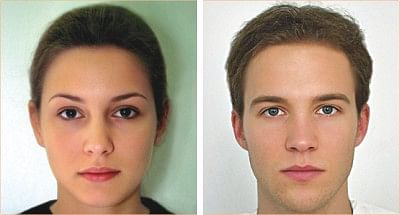Facial beauty: Genes hold secret

L-R: Prototypic female face of high attractiveness and prototypic male face of high attractiveness
Evolution, selection, adaptation- these nearly similar terms may lead someone into confusion. But the thing, what can be extracted, common from all these terms is the genetic sequence change or mutations over time. These alterations do matter a lot and these account for many of our interactions. MHC genes (Major Histocompatibility Complex), a cluster of genes that plays a major role in the immune system, are a very good target for accounting the genetic diversity. Genetic diversity has been linked to fitness and reproductive success in general, and genetic diversity within the MHCs has been linked to immunocompetence and mate preferences. Hanne C. Lie et al; has performed a study published online in October 2008 issue of Evolution. They have photographed and genotyped 160 participants using microsatellite markers, one class of repeating sequences in DNA, situated within and outside the MHC, and calculated genetic diversity and found MHC heterozygosity, different gene sequences responsible for the same trait, is associated with male attractiveness and specifically facial averageness, with averageness mediating the MHC-attractiveness relationship. In fact, females and males both show tendency to be attracted by facial cues written in their MHCs and some non-MHC sites.
In the Science Magazine of 17 January, 2009 issue, Elizabeth Quill has described this in a bit interesting way, "Eye candy might more appropriately be called brain candy. In fact, attractive faces activate the same reward circuitry in the brain as food, drugs and money". "Faces are interesting because they impart so much information- expression, attention- and these interact with facial beauty"- Anthony Little of the University of Sterling in Scotland, says."When you look at what people find attractive; it is consistent across cultures", says evolutionary psychologist Hanne C. Lie of the University of Western Australia in Perth. "We have some innate or hardwired beauty detector", he added. Although beauty is in the eye of the beholder, researchers, taking the facial cues as the basis use three terms to define beauty- averageness, symmetry and sexual dimorphism. Averageness, one researcher quipped, could account for as much as 85 percent of good looks. Symmetry as a feature of attractiveness dates back to Plato'S day. He believed the "golden proportion" was the key to a good looking face. Finally, sexually dimorphic characteristics-meaning those that make someone very masculine or very feminine-can take from beautiful to something more than beautiful! These can be blinking, nodding and head tilting-the indicators of femininity through face movements-made women's faces more attractive to male and female volunteers, Morrison reported in a 2007 paper in the journal, 'Evolution and Human behavior'.
Now, coming back to the MHCs; scientists do believe that mate quality may include genetic diversity, especially at loci, the location of genes on the chromosomes, linked to immune functioning within the major MHCs (or in humans, human leucocyte antigen, HLA). A recent experiment suggests that females prefer faces of MHC- heterozygous men to faces of MHC-homozygous men. The Hanne C. Lie group showed the first ever link of female facial appearance to genetic diversity. They found that MHC plays a special role in male facial attractiveness, whereas female facial symmetry is associated with allelic dissimilarity at non-MHC loci. Thus human faces provide facial cues to genetic diversity and/or quality in both males and females. This supports the evolutionary theories proposing that our face preferences have been shaped by selection pressures. But still, many miles to go. Lots of studies need to be carried out to get the overall idea of facial attractiveness and related things. Again quoting from Elizabeth Quill, "The next time a face catches your eye, you may not be able to articulate what turns your head or makes your heart jump, but you will certainly know what you feel. Call it instinct, call it evolution, call it what you want. It may take researchers many more years to understand why you find a super-fine face to be so sweet."

 For all latest news, follow The Daily Star's Google News channel.
For all latest news, follow The Daily Star's Google News channel. 



Comments